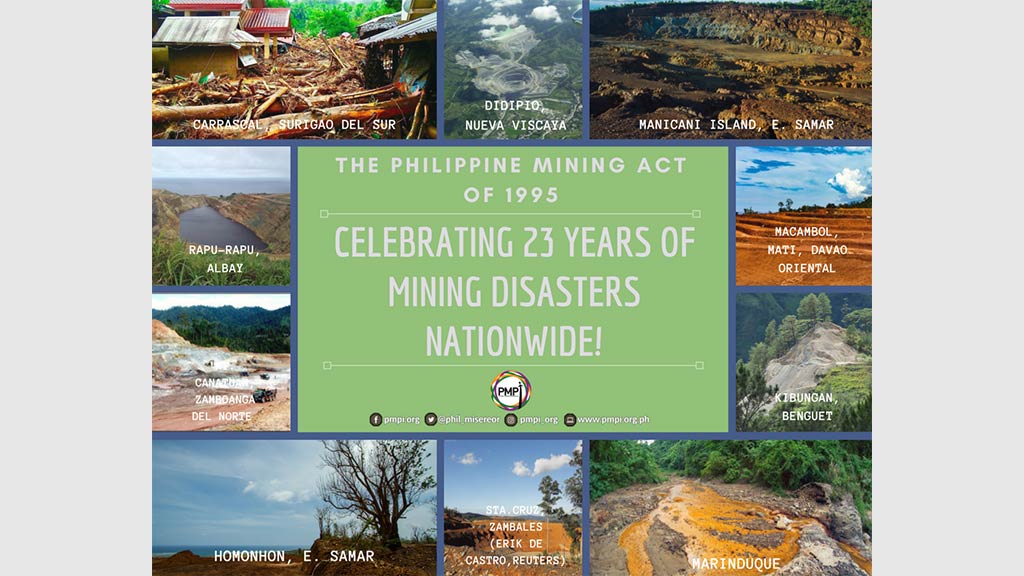Bust that Philippine Mining Act!
The Philippine Mining Act of 1995 was born out of global pressure from international markets to open up the Philippines’ mineral resources, particularly the growing demand of China for industrial and metallic minerals. That said, the overall framework for “managing” the Philippine mineral resources is to further liberalize the sector. Agents of capital and apologists alike made sure of that and paved the way to the passage of the Philippine Mining Act! It was ruled unconstitutional after seven years of deliberation of the La Bugal-B’laan Case but the MGB together with the mining companies were quick to appeal the decision of the High Tribunal. Just as President Gloria Macapagal Arroyo issued her revitalization order and the Supreme Court reversed its decision later that year, it paved the way to the liberalization of the mining industry.
Even with the passage of the Philippine Mining Act, mining disasters were happening left and right: In 1996, Marinduque especially its Makulapnit River and Boac River as well as the west side of the island were devastated by mining spillage and an estimated 22,500 people from five (5) barangays near the river were affected, while large tracts of biodiversity died off as a result. According to MGB Officials, Marcopper owns the mine site and wants to mine the site again rather than ensure rehabilitation and reparation for the victims. Even as the Philippine Mining Act was already enacted and there are “so-called provisions” in the law on environmental protection but victims of the Marcopper disaster have yet to receive justice.
In 2005, Lafeyatte Mining Corporation’s Rapu-rapu Island mine site was the new poster boy for mining disaster. The mine site had cyanide spills that caused massive fish kills, among others. It has become the MGB’s poster project to portray the ‘feasibility’ of mine rehabilitation but as of this date, the mine site does not bear any resemblance to a rehabilitated mining area. Similar to this is the case of the Canatuan Mining project of TVI Resources in Zamboanga del Norte. Communities in both projects continue to fear spills from tailings ponds as it will heavily impact their livelihood and the community in general.
Seventeen (17) years since the passage of the Philippine Mining Act, the mine tailings pond of Philex Pacdal Mines in Benguet leaked about 20 Million MT of mine tailings in Balog and Agno Rivers affecting the San Roque Dam which supplies water to agricultural irrigation and power generation for the province.
The case of Manicani Island, in Guiuan, Eastern Samar is a fairly recent one. The island is part of the Guiuan Protected Seascape/Landscape under the National Integrated Protected Areas System (NIPAS) Act, and yet, despite the Philippine Mining Act’s provision on rehabilitation (Section 71) Hinatuan Mining Corporation – a subsidiary of Nickel Asia Corporation – has yet to start the rehabilitation of mined sites even with the expiration of its Mineral Production Sharing Agreement (MPSA) last October 27, 2017. The adjoining island, Homonhon is home to several endangered species and declared a historical site but minerals map from the MGB shows that the entire island is covered by mining permits, exploration permits, and applications for exploration. One can only wonder why the Municipality of Guiuan whose islands host several endangered species and whose marine waters are covered by the Guiuan protected seascape and landscape was not included in the Samar Island National Park.
Let us also not forget the Tampakan Copper and Gold Project – potentially, among the world’s largest copper open pit mines, with an estimated mine site cover of 10,000 hectares according to Asuenco, will affect Mal River, Mindanao’s biggest river system, and 5 other rivers. Furthermore, the mining permit (called FTAA/Financial or Technical Assistance Agreement) largely covers the ancestral domain of the B’laans whose lives and culture are threatened. Its projected environmental impact according to BankTrack, will affect 935 hectares including old growth Rainforest, and produce waste rock of 2.6 Billion tons of 300 meters high and area coverage of 500 hectares.
The performance of mining corporations under the regime of the Philippine Mining Act in the context of job generation, revenue from taxes, and contribution to the country’s Gross Domestic Product (GDP) is dismal: Data from the Mines and Geosciences Bureau (MGB) present tell-tale signs that jobs generated from the mining sector (mining and quarrying combined) are nothing but miniscule – in 2003 – 0.7% and declined to 0.5% as of July 2017 vis-à-vis Philippine total employment. This means the mining sector is indeed technology-intensive, thus labour-saving! Furthermore, the mining sector’s contribution to GDP for the above-mentioned years reveal a meager 0.6% to 0.7% annually. Total taxes (Taxes, Fees and Royalties from Mining) paid by mining corporation in 2016 was valued at P33,465.1 Million, in the first half of the year 2017 was only P 2,005.5 Million. Meanwhile, it boasted an export value of $2,317 Million in 2016.
We need an alternative mining law that will REALLY protect the rights, culture, lives, and livelihood of Indigenous Peoples, as well as benefit our country, manage our natural resources, compel mining companies to rehabilitate mined sites, and penalize the entire top management of erring mining corporations. It’s time we bust that Philippine Mining Act! Pass the Alternative Minerals Management Bill NOW!
Sources:
PMPI Position Paper on the Alternative Minerals Management Bills
Mines and Geosciences Bureau
Senate of the PH
De La Salle University, Manila
BankTrack
JournalsOpenEdition

